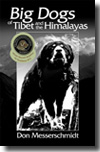| Our Publications | ||
| Books by Title | ||
| Books by Author | ||
| Books by Country | ||
| E-books | ||
| About | ||
| Orchid Press E-books | ||
| Distributed E-books | ||
| Our Bookshop | ||
| About Us | ||
| Browse Shop | ||
| How to Buy | ||
| Contact Us | ||
| WE BUY BOOKS AND LIBRARIES | ||
|
||
Book Reviews

Big Dogs of Tibet and the Himalayas
A Personal Journey
byDon Messerschmidt
2010, xiv, 268 pp., 40 b & w illustrations, 5 maps, bibliography, index, 23 x15 cm., softbound.
ISBN-13: 978-974-524-130-5 $29.50
A Quest for the Authentic
Book review by Daniel Taylor
http://literarydogs.com
May 4 2013
This remarkable book is worth reading—even if a reader is not particularly interested in big dogs of Tibet and the Himalaya. In 246 pages Messerschmidt, whose fifty years of Himalayan work and wandering brings together Marco Polo, the question of what is a dog breed, the tangled strings of the Tibetan Mastiff, with his personal saga of being part of creating that dog breed. It sounds confusing, but it is not. The dog holds it all together.
Humans and dogs are the oldest people-animal relationship, 15,000 years old, and using dogs is a useful way to look at people. One of the great chapters in this relationship, the Tibetan Mastiff is embraced in this book. What was Marco Polo’s legendary dog that is alleged by many to be a progenitor of Europe’s large dog breeds: Great Pyrenees, St Bernard, English Mastiff, and others? Large, semi-wild dogs repeatedly came out of the Tibetan Plateau into Europe and China and became domesticated. In doing so they developed into what we now term breeds but in their homeland were a cacophony of canine genes. The Tibetan Mastiff is a name loosely applied to most of these.
Messerschmidt makes clear that the Tibetan Mastiffs being sold now in the Lhasa Bazaar are not authentic Tibetan Mastiffs. (A few months ago Chinese newspaper reported a shocking-red pup selling for almost a million dollars.) My totally independent research in this area points to their cross-breeding with Newfoundland, Shar Pei, Bloodhounds, Chow Chows, and goodness knows what else. The point is that people change dogs to be the image of what they want. But such are not dogs Messerschmidt is interested in: this book is a quest by an anthropologist for the authentic.
Once dogs roamed freely with humans, and here the author tells a nice series of stories about such roaming ways. There is the Kinnauri mastiff he came across walking with his master in north India. There is the very shaggy mastiff he met accompanying a trader in far northwestern Nepal. Perhaps closest to his heart is Amjo, a companion with whom he trekked maybe a thousand miles throughout the Nepal Himalaya. Flipping the pages of this book is an easy way to flip through some rather remarkable valleys with some remarkable people during times now pretty much gone.
What is a Tibetan Mastiff? Messerschmidt works all around this question—and correctly does not answer it. A Tibetan Mastiff is one thing in a US show ring where the American Tibetan Mastiff Association firmly created a strict standard (after it had to rub out some of its own cross-breeding from Newfoundlands in the 1970s). In Europe there is a different standard. In Nepal and India (where the author raised his dogs) there is a further standard. And in the Lhasa dog market it is whatever sells.
It is important not to do, as many dog lovers do, and put a more suitable suit on your dog. Given the 15,000 years we people have been working with dogs we’ve tried to create them into our own image. Messerschmidt makes a point of deromanticising what is otherwise a very romantic “breed”—and his terrier-like, never-letting-go argument, taking on one treasured belief after another, makes his book good reading.
Reviewer’s Note: The author and I have known of each other for many years, on perhaps three occasions actually meeting. Being both lovers of the “big Himalayan dogs” in those encounters we’ve had some robust arguments. My particular preference in Himalayan dogs is the KyiApso which features in this book with the question whether it is a separate breed from the Tibetan Mastiff—he argues it isn’t, I argue it is because the American Tibetan Mastiff Association would not recognize it and told us that we had to go as a separate breed, which subsequently the American Rare Breed Association recognized. The point is not that debate, but the point that Messerschmidt makes as the core theme of his book: when you view this one ‘breed’ across a thousand years, well, it is not what many are trying to make it today.
[Read a review from ECS Nepal] [Read a review from Chowkidar Magazine] [Read a review from Amazon.com] [Read a review from Peace Corps Worldwide] [Read a review from The Italian Tibetan Mastiff Club] Download an excerpt from the book, published in ECS Nepal. [More Orchid Press Reviews]
PO Box 70, Trinity TB, NL, A0C 2S0, Canada
Telephone: +1 709-330-4703